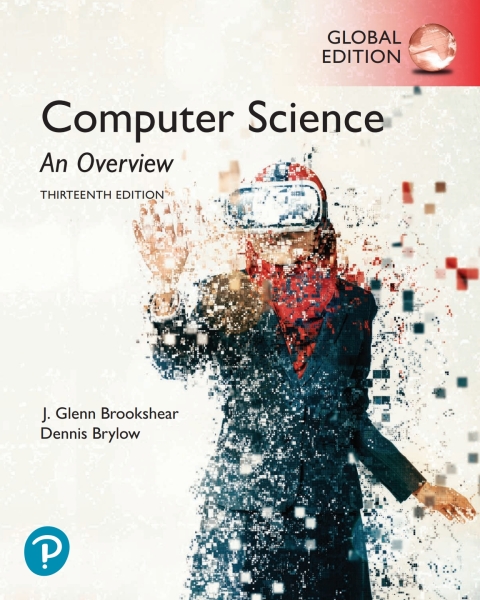Description
Efnisyfirlit
- Title Page
- Copyright Page
- Dedication Page
- Contents
- Preface Page
- Acknowledgment Page
- Chapter 0 Introduction
- 0.1 The Role of Algorithms
- 0.2 The History of Computing
- 0.3 An Outline of Our Study
- 0.4 The Overarching Themes of Computer Science
- Chapter 1 Data Storage
- 1.1 Bits and Their Storage
- 1.2 Main Memory
- 1.3 Mass Storage
- 1.4 Representing Information as Bit Patterns
- 1.5 The Binary System
- 1.6 Storing Integers
- 1.7 Storing Fractions
- 1.8 Data and Programming
- 1.9 Data Compression
- 1.10 Communication Errors
- Chapter 2 Data Manipulation
- 2.1 Computer Architecture
- 2.2 Machine Language
- 2.3 Program Execution
- 2.4 Arithmetic/Logic Instructions
- 2.5 Communicating with Other Devices
- 2.6 Programming Data Manipulation
- 2.7 Other Architectures
- Chapter 3 Operating Systems
- 3.1 The History of Operating Systems
- 3.2 Operating System Architecture
- 3.3 Coordinating the Machine’s Activities
- 3.4 Handling Competition Among Processes
- 3.5 Security
- Chapter 4 Networking and the Internet
- 4.1 Network Fundamentals
- 4.2 The Internet
- 4.3 The World Wide Web
- 4.4 Internet Protocols
- 4.5 Simple Client Server
- 4.6 Cybersecurity
- Chapter 5 Algorithms
- 5.1 The Concept of an Algorithm
- 5.2 Algorithm Representation
- 5.3 Algorithm Discovery
- 5.4 Iterative Structures
- 5.5 Recursive Structures
- 5.6 Efficiency and Correctness
- Chapter 6 Programming Languages
- 6.1 Historical Perspective
- 6.2 Traditional Programming Concepts
- 6.3 Procedural Units
- 6.4 Language Implementation
- 6.5 Object‐Oriented Programming
- 6.6 Programming Concurrent Activities
- 6.7 Declarative Programming
- Chapter 7 Software Engineering
- 7.1 The Software Engineering Discipline
- 7.2 The Software Life Cycle
- 7.3 Software Engineering Methodologies
- 7.4 Modularity
- 7.5 Tools of the Trade
- 7.6 Quality Assurance
- 7.7 Documentation
- 7.8 The Human‐Machine Interface
- 7.9 Software Ownership and Liability
- Chapter 8 Data Abstractions
- 8.1 Basic Data Structures
- 8.2 Related Concepts
- 8.3 Implementing Data Structures
- 8.4 A Short Case Study
- 8.5 Customized Data Types
- 8.6 Classes and Objects
- 8.7 Pointers in Machine Language
- Chapter 9 Database Systems
- 9.1 Database Fundamentals
- 9.2 The Relational Model
- 9.3 Object‐Oriented Databases
- 9.4 Maintaining Database Integrity
- 9.5 Traditional File Structures
- 9.6 Data Mining
- 9.7 Social Impact of Database Technology
- Chapter 10 Computer Graphics
- 10.1 The Scope of Computer Graphics
- 10.2 Overview of 3D Graphics
- 10.3 Modeling
- 10.4 Rendering
- 10.5 Dealing with Global Lighting
- 10.6 Animation
- Chapter 11 Artificial Intelligence
- 11.1 Intelligence and Machines
- 11.2 Perception
- 11.3 Reasoning
- 11.4 Additional Areas of Research
- 11.5 Artificial Neural Networks
- 11.6 Robotics
- 11.7 Considering the Consequences
- Chapter 12 Theory of Computation
- 12.1 Functions and Their Computation
- 12.2 Turing Machines
- 12.3 Universal Programming Languages
- 12.4 A Noncomputable Function
- 12.5 Complexity of Problems
- 12.6 Public‐Key Cryptography
- Appendixes
- A ASCII
- B Circuits to Manipulate Two’s Complement Representations
- C Vole: A Simple Machine Language
- D High‐Level Programming Languages
- E The Equivalence of Iterative and Recursive Structures
- F Answers to Questions & Exercises
- Index
- Back Cover







Reviews
There are no reviews yet.